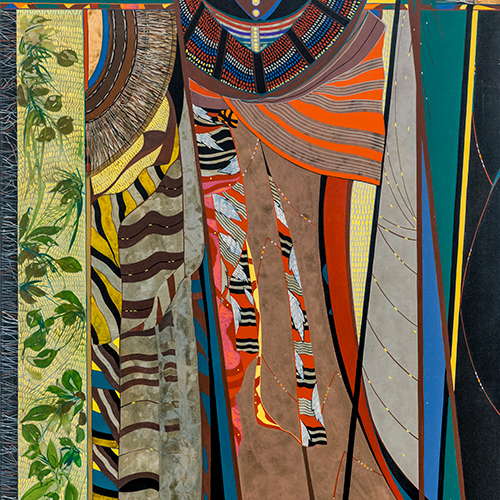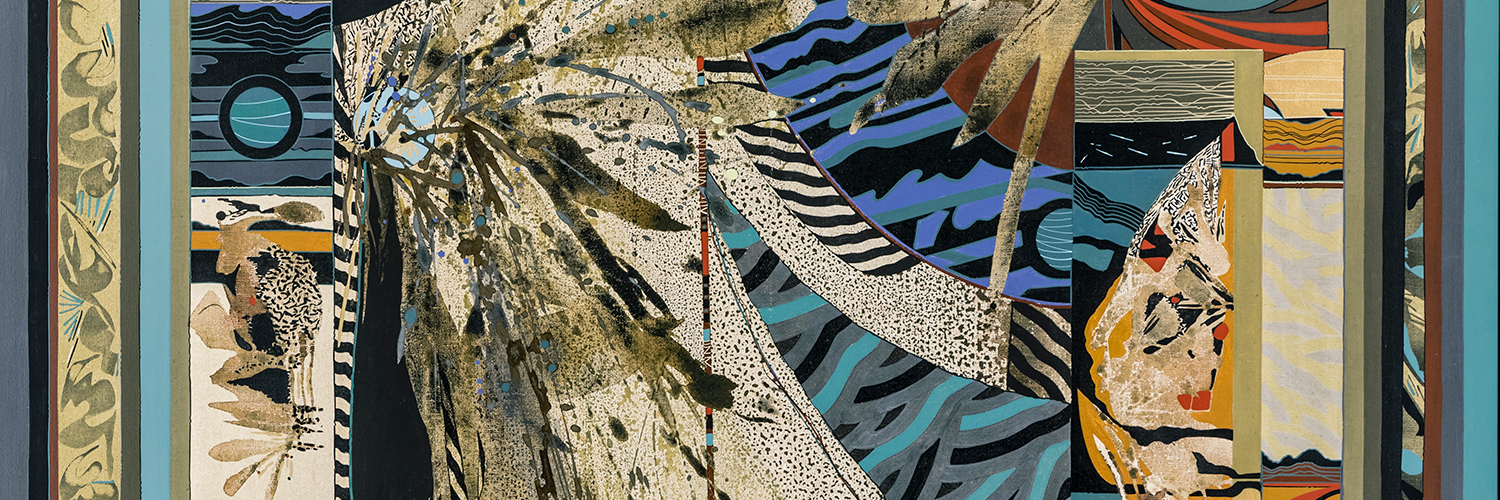
Brenda Kingery: Weaving Messages
October 6 – December 19, 2021
Brenda Kingery: Weaving Messages presents a series of narrative abstract paintings whose vivid expressions draw from the artist’s global cultural vision and Chickasaw heritage. The exhibition contains 12 large-scale artworks ranging from the artist’s formative pieces, contemporary mature works, and new paintings. Kingery has traveled widely and influences on her work include the artists of the Ryukyuan Islands of Japan, indigenous communities in Mexico and Central America, remote villages in Uganda, as well as powwow celebrations in her native Oklahoma. Kingery’s perspective is both international and humanitarian; her artworks refer to textile, dance, drum and song traditions as living reminders of peoples’ resilience and strength in preserving and celebrating their cultures.
Brenda Kingery: Weaving Messages is curated by Heather K. Lunsford, Director of the School of Visual Art, Oklahoma City University

Brenda Kingery is a contemporary artist and champion of women’s empowerment around the world. Born in Oklahoma City in 1939, Kingery earned a bachelor’s degree in fine arts and history from the University of Oklahoma. She attended graduate school at Ryukyus University in Okinawa and completed a master’s degree in arts from the University of Oklahoma.
Kingery returned to Okinawa, where she taught drawing, painting, and Okinawan cultural history for the University of Maryland’s Far East division. She later settled in San Antonio, Texas, where she taught at San Antonio College. Her artwork has been displayed in many private, corporate, and public collections around the world and is part of numerous permanent collections.
Kingery is a founding member of Threads of Blessing International, an organization that teaches textile art and design to women in developing countries to use their indigenous artistic skills. As well as being an influential artist and teacher, Kingery has been honored multiple times as a member of the Chickasaw Nation. She was inducted into Chickasaw Nation Hall of Fame and honored as Dynamic Woman of the Year for the Chickasaw Nation for her efforts to empower women around the world. Kingery was appointed by the President of the United States to the board of trustees of the Institute of American Indian and Alaska Native Culture and Arts Development (IAIA) in Santa Fe, New Mexico.
Brenda Kingery captures her life experiences in her vividly colored and emotionally resonant paintings. A native Oklahoman, she grew up riding a cutting horse and absorbing the colors and textures of the land. “There’s a certain color,” Kingery said, discussing how she perceives Oklahoma. “There’s the wheat; it was a big influence. The warm summers, the winds, and then my Native American background was a portion of it.”
Living in Japan and immersing herself in another culture was formative for Kingery. In Okinawa, she learned the ink wash, or sumi-e, method of painting, which she still utilizes today along with multiple layers of acrylic washes. But this point in her life was also the first of many phases of travel reflected in her work. Whenever she went somewhere new, it became important for Kingery to learn from and absorb her surroundings. Textiles, in particular, have served as a key inspiration.
Kingery believes artists must grow and change or they risk becoming stagnant. She sees the evolution of her style as different series and genre shifts marked by life changes, like moving between countries and connecting with her heritage.
“It’s interesting that all of these experiences compound to work on each other,” Kingery said. “And eventually you come to something that’s yours.”
Throughout her artistic career, Brenda Kingery has been drawn to the stories and traditions expressed within cultures. As a citizen of the Chickasaw Nation, Kingery recognizes the strength it takes to preserve a culture. Each textile, dance, drum, and song is a living reminder of peoples’ resilience in the face of conflict. This frame of thought informed her artwork while she traveled through the Ryukyuan Islands of Japan, indigenous communities in Mexico and Central America, remote villages in Uganda, and Powwow celebrations in her native Oklahoma. Kingery has cultivated a global identity while remaining tied to her Chickasaw history, keen to paint the “little seeds” that shine.
Stylistically, Kingery developed her painting techniques by observing a range of artistic traditions. While studying fine arts at the University of Oklahoma, she was introduced to Abstract Expressionism as it rose to popularity in the United States. This artistic movement, identified by a lack figuration and loose brushstrokes, set the foundation for Kingery’s early works. She later evolved this style with inspiration from Mughal paintings of Southeast Asia, known for detailed and intricate miniatures. By the time she graduated with her bachelor’s degree in 1961, Kingery was integrating two unique styles: allowing for chaos, then refining with control.
This painting technique developed and deepened once Kingery migrated to Okinawa, Japan, in 1968. An Air Force wife with two young children, Kingery carved out time and patience to learn from master artists. She befriended weavers and potters, and was inspired to paint Okinawan textiles, textures, and tales into her artwork. While in Japan, Kingery studied beneath a renowned sumi-e (ink wash) painter and honed her skill in the ancient Japanese art of ink, water, and brush. Kingery deeply absorbed this tradition, one that continues to shape her technique today. She still begins with thin ink washes, then adds fine hand-painted lines and acrylic washes in as many as 25 layers.
After Okinawa, Kingery returned to the United States and earned her master’s degree in fine arts from Oklahoma University. Her family later moved to Texas while maintaining connections to Oklahoma. In 1994, she attended her first Red Earth Festival and Powwow. The diverse dances, regalia and music expressed by Native peoples served as instant inspiration. “When I saw Red Earth, I nearly fell over, it was so fantastic,” Kingery said. “It just turned me around. It started a whole new series of paintings that I’m still working on to this day.”
Though her own grandmother passed down family stories and memories, Kingery had not been raised amongst Chickasaw arts or community events. After her Red Earth experience, Kingery began reconnecting with her heritage and retooled her paintings to include a Native American spirit and sentiment. Preservation of culture became a key thematic element of her work.
In her most contemporary works, Brenda Kingery blends global experience with subjective interpretation. She celebrates the transformation that occurs when imagination collaborates with memory, and uses her canvas to explore time, place, and culture. On exhibit are twelve paintings that span Kingery’s career, representing the shifts that her art and worldview have taken. “If we would slow down and look, this is such a planet! And there’s so much to see,” Brenda Kingery exclaims. Through this exhibition, you can slow down, look, and see the world in Kingery’s canvas.
Brenda Kingery: Weaving Messages is curated by Heather K. Lunsford, Director of the School of Visual Art, Oklahoma City University.
The Cahoon Museum of American Art acknowledges that it was founded and built upon unceded Native homelands of the Wampanoag Nation, People of the First Light, in Cotuit or “place of the counsel” on Cape Cod.
We begin with a breath of gratitude for their ancestors and modern day descents, and for the birds, insects, animals and other beings that continue to grace the air, rivers, grasslands, bogs, cedar swamps, forests, and beach, that are both seasonally and permanently here, as well as the whales, dolphins, seals, turtles, sharks, fish, shellfish and crustaceans in the Atlantic ocean surrounding.
We echo the existing Federal tribal nations of Mashpee and Aquinnah in recognizing these lands and waters as important Relations with which we are all interconnected and dependent on to sustain our life, culture and wellbeing. Mashpee and Aquinnah were places of refuge for tribal communities on Cape Cod and beyond, and who encourage responsible and sustainable stewardship of Turtle Island.
– ELIZABETH JAMES PERRY, WAMPANOAG TRIBE OF AQUINNAH

